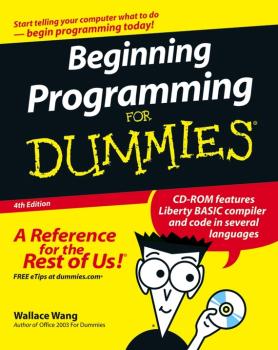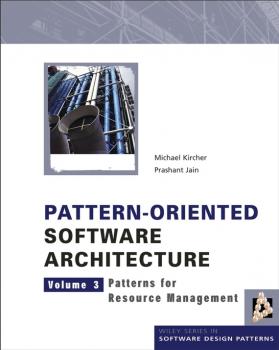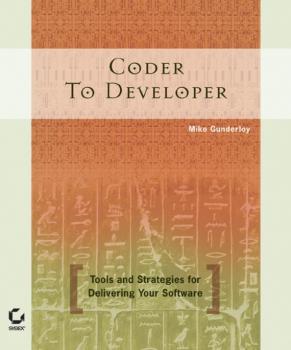Программирование
Различные книги в жанре ПрограммированиеAjax For Dummies
Ajax is short for “Asynchronous JavaScript+CSS+DOM+XMLHttpRequest.” Even if you weren’t intimidated before, that tidbit is probably enough to make you reach for the Excedrin. Just reach for Ajax For Dummies instead. With screen shots, actual code and explanations, and live Web sites where you can see Ajax applications doing their thing, it will have you using Ajax to create Web applications that look an act like desktop applications in no time. With Ajax, you can speed up and clean up your Web applications. Shoppers at your online store can fill their carts without waiting for multiple page refreshes. Searchers on your sites can get instant results on the same page. This guide takes you on a tour of how Ajax is used today, complete with examples of Ajax applications in action, such as an Ajax-enabled Yahoo! search or an Ajax-based chat application. Then it gives you basics on using JavaScript. After that you dive in and get info on: Writing some Ajax, interactive mouseovers using Ajax, passing data to the server with GET or POST, and more Connecting to Google for a live search Using free Ajax frameworks so you don’t have to start from scratch, including Ajax Gold (written specifically for this book), AJAXLib, and grabbing XML with libXmlRequest All kinds of Ajax techniques, such as using Ajax for drag-and-drop operations, pop-up menus, downloading images behind the scenes, and more Using SACK (simple AJAX code kit), decoding XML with Sarissa, and creating visual effects with Rico Handling XML int Ajax Applications Working with cascading style sheets (CCS) in Ajax, including setting up the styles, displaying a menu, styling text, handling colors and backgrounds, and more Working with Ajax and PHP Complete with a companion Web site, free Ajax frameworks, and sample code you can use, Ajax for Dummies is your friendly guide to creating truly user-friendly Web sites! Note: CD-ROM/DVD and other supplementary materials are not included as part of eBook file.
Beginning Programming For Dummies
Do you think the programmers who work at your office are magical wizards who hold special powers that manipulate your computer? Believe it or not, anyone can learn how to write programs, and it doesn’t take a higher math and science education to start. Beginning Programming for Dummies shows you how computer programming works without all the technical details or hard programming language. It explores the common parts of every computer programming language and how to write for multiple platforms like Windows, Mac OS X, or Linux. This easily accessible guide provides you with the tools you need to: Create programs and divide them into subprograms Develop variables and use constants Manipulate strings and convert them into numbers Use an array as storage space Reuse and rewrite code Isolate data Create a user interface Write programs for the Internet Utilize JavaScript and Java Applets In addition to these essential building blocks, this guide features a companion CD-ROM containing Liberty BASIC compiler and code in several languages. It also provides valuable programming resources and lets you in on cool careers for programmers. With Beginning Programming of Dummies, you can take charge of your computer and begin programming today!
Oracle PL / SQL For Dummies
Find tips for creating efficient PL/SQL code If you know a bit about SQL, this book will make PL/SQL programming painless! The Oracle has spoken—you need to get up to speed on PL/SQL programming, right? We predict it'll be a breeze with this book! You'll find out about code structures, best practices, and code naming standards, how to use conditions and loops, where to place PL/SQL code in system projects, ways to manipulate data, and more. Discover how to Write efficient, easy-to-maintain code Test and debug PL/SQL routines Integrate SQL and PL/SQL Apply PL/SQL best practices Use new features introduced in Oracle 9i and 10g
Pattern-Oriented Software Architecture, Patterns for Resource Management
The first volume of the POSA pattern series introduced a broad-spectrum of general-purpose patterns in software design and architecture. The second narrowed the focus to fundamental patterns for building sophisticated concurrent and networked software systems and applications. This volume uses design patterns to present techniques for implementing effective resource management in a system. The patterns are covered in detail making use of several examples providing directions to the readers on how to implement the presented patterns. Additionally, the volume presents a thorough introduction into resource management and a case study where the patterns are applied to the domain of mobile radio networks. The patterns are grouped by different areas of resource management and hence address the complete lifecycle of resources: resource acquisition, coordination and release.
Managing the Testing Process. Practical Tools and Techniques for Managing Hardware and Software Testing
New edition of one of the most influential books on managing software and hardware testing In this new edition of his top-selling book, Rex Black walks you through the steps necessary to manage rigorous testing programs of hardware and software. The preeminent expert in his field, Mr. Black draws upon years of experience as president of both the International and American Software Testing Qualifications boards to offer this extensive resource of all the standards, methods, and tools you'll need. The book covers core testing concepts and thoroughly examines the best test management practices and tools of leading hardware and software vendors. Step-by-step guidelines and real-world scenarios help you follow all necessary processes and avoid mistakes. Producing high-quality computer hardware and software requires careful, professional testing; Managing the Testing Process, Third Edition explains how to achieve that by following a disciplined set of carefully managed and monitored practices and processes The book covers all standards, methods, and tools you need for projects large and small Presents the business case for testing products and reviews the author's latest test assessments Topics include agile testing methods, risk-based testing, IEEE standards, ISTQB certification, distributed and outsourced testing, and more Over 100 pages of new material and case studies have been added to this new edition If you're responsible for managing testing in the real world, Managing the Testing Process, Third Edition is the valuable reference and guide you need.
Agile Modeling. Effective Practices for eXtreme Programming and the Unified Process
The first book to cover Agile Modeling, a new modeling technique created specifically for XP projects eXtreme Programming (XP) has created a buzz in the software development community-much like Design Patterns did several years ago. Although XP presents a methodology for faster software development, many developers find that XP does not allow for modeling time, which is critical to ensure that a project meets its proposed requirements. They have also found that standard modeling techniques that use the Unified Modeling Language (UML) often do not work with this methodology. In this innovative book, Software Development columnist Scott Ambler presents Agile Modeling (AM)-a technique that he created for modeling XP projects using pieces of the UML and Rational's Unified Process (RUP). Ambler clearly explains AM, and shows readers how to incorporate AM, UML, and RUP into their development projects with the help of numerous case studies integrated throughout the book. AM was created by the author for modeling XP projects-an element lacking in the original XP design The XP community and its creator have embraced AM, which should give this book strong market acceptance Companion Web site at www.agilemodeling.com features updates, links to XP and AM resources, and ongoing case studies about agile modeling.
Professional XML Development with Apache Tools. Xerces, Xalan, FOP, Cocoon, Axis, Xindice
What is this book about? If you're a Java programmer working with XML, you probably already use some of the tools developed by the Apache Software Foundation. This book is a code-intensive guide to the Apache XML tools that are most relevant for Java developers, including Xerces, Xalan, FOP, Cocoon, Axis, and Xindice. Theodore Leung, a founding member of the Apache XML Project, focuses on the unique capabilities of these best-of-breed XML tools. With the help of a sample application, he demonstrates how you can use them in unison to develop professional XML/Java applications for the real world. If you need in-depth information to help you assemble a workable toolbox for developing sophisticated XML-based applications, you'll find it in this volume. What does this book cover? In this book, you will find out about the following: How the Apache XML Project relates to Java programming When you'll need some of Xerces' extra parsing features, like grammar caching How to use Xalan's XSLTC to compile XSLT stylesheets into Java Prerequisites and applications for FOP and Batik Cocoon concepts and development Development techniques and practical usage for Xindice How to develop back-end applications with XML RPC and Axis Applications and concepts for XML Security Who is this book for? This book is written for professional Java developers who have had some exposure to XML and XSLT. To get the most from it, you should be familiar with Java, Java Web development technologies (e.g., servlets), and the command line Java tools.
Coder to Developer. Tools and Strategies for Delivering Your Software
"Two thumbs up" —Gregory V. Wilson, Dr. Dobbs Journal (October 2004) No one can disparage the ability to write good code. At its highest levels, it is an art. But no one can confuse writing good code with developing good software. The difference—in terms of challenges, skills, and compensation—is immense. Coder to Developer helps you excel at the many non-coding tasks entailed, from start to finish, in just about any successful development project. What's more, it equips you with the mindset and self-assurance required to pull it all together, so that you see every piece of your work as part of a coherent process. Inside, you'll find plenty of technical guidance on such topics as: Choosing and using a source code control system Code generation tools–when and why Preventing bugs with unit testing Tracking, fixing, and learning from bugs Application activity logging Streamlining and systematizing the build process Traditional installations and alternative approaches To pull all of this together, the author has provided the source code for Download Tracker, a tool for organizing your collection of downloaded code, that's used for examples throughout this book. The code is provided in various states of completion, reflecting every stage of development, so that you can dig deep into the actual process of building software. But you'll also develop «softer» skills, in areas such as team management, open source collaboration, user and developer documentation, and intellectual property protection. If you want to become someone who can deliver not just good code but also a good product, this book is the place to start. If you must build successful software projects, it's essential reading.
Java 2: Web Developer Certification Study Guide. Exam 310-080
Here's the book you need to prepare for Exam 310-080, Sun Certified Web Component Developer for J2EE Platform. This Study Guide provides: In-depth coverage of every exam objective Practical information on programming servlets, developing JSP pages, and using custom tags Hundreds of challenging review questions, in the book and on the CD Leading-edge exam preparation software, including a testing engine Authoritative coverage of all exam objectives, including: The structure and deployment of modern servlet web applications The servlet container model Designing and developing servlets to handle server-side exceptions Designing and developing servlets using session management Designing and developing secure web applications Designing and developing thread-safe servlets The JavaServer Pages (JSP) technology model Designing and developing reusable web components Designing and developing JSP pages using JavaBean components and custom tags Designing and developing a custom tag library Design patterns Note: CD-ROM/DVD and other supplementary materials are not included as part of eBook file.
Java 2 Micro Edition. Professional Developer's Guide
An in-depth tutorial on how to use Java 2 Micro Edition to program handheld devices Although Java is one of the most popular programming languages, it is too powerful to be used on wireless, handheld devices like the Palm Connected Organizer. A miniature version of Java, called Java 2 Micro Edition, has now been created by Sun Microsystems to run specifically on these devices. Written by software developer Eric Giguere, this book provides an authoritative treatment of this new language. Readers will learn what has to be done to make Java workable on these devices and what strategies are required to write programs that don't take up too much memory or run down the device's batteries. The book also provides complete coverage of Java Micro Edition, including the profiles that define the capabilities available to various devices. CD-ROM includes licensed versions of the Java 2 Micro Edition SDK, Waba, and Kaffe. Examples are provided that run on multiple wireless platforms.









